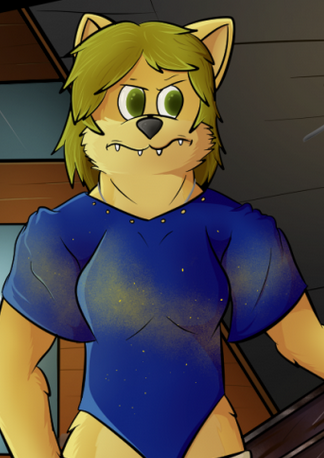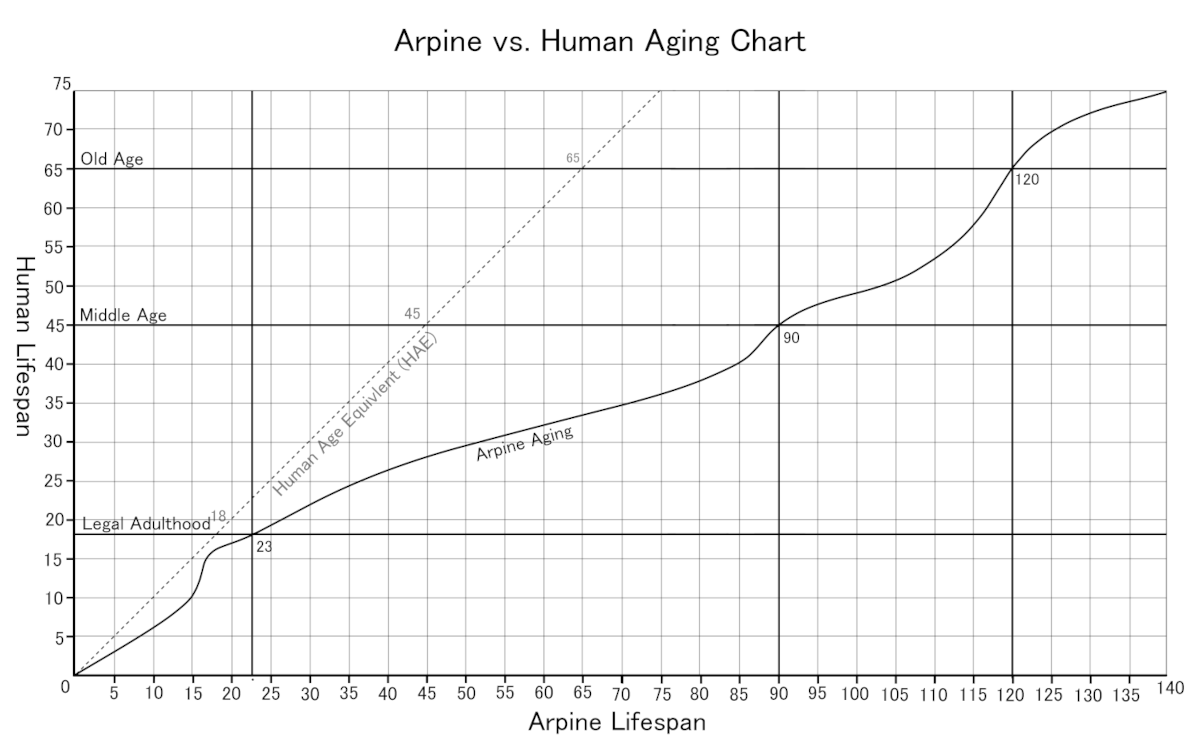>HUNT-OS V 2.15.1 - USER PROFILE: Grey Windstorm
-Viewing Wiki
Loaded Article: ReproductionAndLifespan.html: >_
Chloe Vortex

Yes, I am in my 60s.
What, you surprised?
I'll have you know I've spent decades doing things you wouldn't believe, loved, birthed and raised a cub who's now 34, and I am still in my prime!
I won't be splitting grey fur for another 20 or 30 years yet. But, wait, isn't it rude to ask a woman about her age in your culture?
AgeGraph.png

A comparison of the Arpine aging cycle to the Human aging cycle. The corresponding human age to an arpine age is known as the Human Age Equivalent (HAE).
Reproduction
Arpines are considered to be slow breeders with an average birthrate of only 2.3 cubs per female, although some individual arpines may have only 1 cub in their lifetime or up to 6, others may not have any cubs at all. Female arpines typically ovulate on a 9-12 month cycle and for a period of 3 weeks. During ovulation the female will feel a specific form of sex drive that differs from her regular sex drive, and if she desires cubs during this time she will look for a long term mate or express her desires to her current mate. Otherwise, she'll abstain from activity until after the ovulation cycle.
Arpines are generally somewhat fertile up until they reach 90 years of age, although most cease from breeding by the time they are 80 and have the bulk of their young before they are 60. Arpines who have more than one cub will typically breed in 5-20 year intervals, and arpines typically birth only one cub at a time while twins are exceptionally rare.
Once impregnated the female will give birth in around or little more than a year. The long gestation period gives arpine fetuses extra time to develop and arpine cubs are usually born with already-hardened bones, full fur, claws, and canines. Arpines are also born with their quills, which are soft at first but harden a few hours after birth. Cubs are reliant on their mother's milk for the first 3-6 months of their lives until their other teeth begin to grow in and they can begin tearing softer flesh. Although the cub's head hasn't fully expanded by this time, allowing for more ease of the birthing process.
Childhood and Adolescence
Arpine cubs are able to begin tearing softer flesh around 5 months old. By 1 year old an arpine cub's head will have fully expanded and they can already reliably walk on two legs and will begin to learn to climb as well. Around 2-5 years of age a cub will develop stronger jaw muscles and they will begin crushing and chewing harder materials while also starting to form more complex vocalizations. Around this time the cub will also begin practicing "hunting" by pouncing on moving objects, stalking animals or other arpines, and will often try to attack anything that isn't an arpine. By 6 years old an arpine's growth and development will stabilize for a while and they will grow steadily until they reach the age of 14. During this time they will develop most of their social skills, begin to learn more about their environment in-depth, and first begin to be mentored by their parents properly.
Arpine puberty kicks in around 14 and concludes around 17, during this time the juvenile will undergo rapid sexual development and a very rapid growth spurt. They will grow a foot or more per year during this time period and will have intense and often violent emotional swings during this time. They will also begin to hunt on their own and will often use these hunts as a productive outlet for their violent aggression. The parent will still be mentoring them during this time and will also begin teaching them combat, both as a way to make them self-sufficient and also to help them relieve aggression.
An arpine's physical growthrate will slow and stabilize around 17 and will settle around 21. During this time the arpine's mind is still not yet fully developed and is still dealing with the hormonal shock of the previous period of rapid physical growth. They will undergo more mental developments and their body will build outwards more until around the age of 23 when the arpine is finally considered an adult.
Adulthood and Later Years
Arpines live 140 years on average. Arpines are considered to be in their "prime" condition until around an average age of 80 after which they will start to slowly decline and become no-longer fertile but are still very much capable of hunting for themselves and others. Their fur will start to "dull" during this time as well. An arpine will still remain in "good" condition until the age of 110. After this age the arpine will still be in "okay" condition and capable of some form of hunting for some time but at some point will begin to age more rapidly and accumulate health conditions which will further hinder them and eventually result in them needing to rely on other arpines for food (typically around 130). Lone arpines in the wild will die once they can no longer hunt, but those in a group can survive another decade or two with group charity. It isn't unheard of for some arpines, upon reaching old age, to choose to die either to take the pressure off their group or to spare themselves a drawn out death where they feel the anguish of no longer being able to help themselves.